
 |
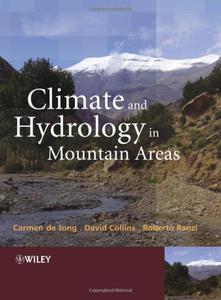 Climate and Hydrology in Mountain Areas By 2005 | 331 Pages | ISBN: 0470858141 | PDF | 35 MB A comprehensive overview ofinteraction ofthe major hydrological and meteorological processes in mountain areas ie Cryosphere and Climatic Change, Snow Melt and Soil Water, Run-off and Floods, Water fluxes and Water Balance, Hydro-meteorological Coupling and Modelling. Each section will reviewrecent research in the field and illustrate key interactions with case studies from mountainous regions in Europe, The Americas and Central Asia.Content: Chapter 1 Alpine Climate Change and Cryospheric Responses: An Introduction (pages 1-4): Roger G. BarryChapter 2 Use of Positive Degree?Day Methods for Calculating Snow and Ice Melting and Discharge in Glacierized Basins in the Langtang Valley, Central Nepal (pages 5-14): Rijan B. Kayastha, Yutaka Ageta and Koji FujitaChapter 3 Surface Energy Balance of High Altitude Glaciers in the Central Andes: The Effect of Snow Penitentes (pages 15-27): Javier G. Corripio and Ross S. PurvesChapter 4 Using Subgrid Parameterisation and a Forest Canopy Climate Model for Improving Forecasts of Snowmelt Runoff (pages 29-44): Ulrich Strasser and Pierre EtcheversChapter 5 Assessment of Snow?Covered Areas Using Air Temperatures During Melt in a Mountainous Basin (pages 45-55): Pratap Singh and Lars BengtssonChapter 6 Permafrost Monitoring in High Mountain Areas Using a Coupled Geophysical and Meteorological Approach (pages 57-71): Christian Hauck, Daniel Vonder Muhll and Martin HoelzleChapter 7 Effects of Frozen Soil on the Groundwater Recharge in Alpine Areas (pages 73-83): Daniel Bayard and Manfred StahliChapter 8 Water Balance in Surface Soil: Analytical Solutions of Flow Equations and Measurements in the Alpine Toce Valley (pages 85-100): Marilena Menziani, Sergio Pugnaghi, Sergio Vincenzi and Renato SantangeloChapter 9 Saturated Hydraulic Conductivity and Water Retention Relationships for Alpine Mountain Soils (pages 101-121): Stefano Barontini, Alberto Clerici, Roberto Ranzi and Baldassare BacchiChapter 10 Water Balance Modeling with Fuzzy Parameterizations: Application to An Alpine Catchment (pages 123-146): Gerald Eder, Hans?Peter Nachtnebel and Murugesu SivapalanChapter 11 Water Relations of an Old?Growth Douglas Fir Stand (pages 147-159): Timothy E. Link, Gerald N. Flerchinger, Mike Unsworth and Danny MarksChapter 12 Comparison of Evapotranspiration and Condensation Measurements between the Giant Mountains and the Alps (pages 161-183): Carmen De Jong, Marco Mundelius and Krzysztof MigalaChapter 13 Climatologic and Hydrologic Coupling in the Ecology of Norwegian High Mountain Catchments (pages 185-214): Jorg Loffler and Ole Ro?lerChapter 14 Runoff and Floods in the Alps: An Overview (pages 215-220): Baldassare Bacchi and Vigilio VilliChapter 15 The Use of Coupled Meteorological and Hydrological Models for Flash Flood Simulation (pages 221-232): Charles A. Lin, Lei Wen, Diane Chaumont and Michel BelandChapter 16 Operational Weather Radar Assessment of Convective Precipitation as an Input to Flood Modelling in Mountainous Basins (pages 233-246): Stefan Uhlenbrook and Doerthe TetzlaffChapter 17 Geomorphological Zoning: An Improvement to Coupling Alpine Hydrology and Meteorology? (pages 247-260): Carmen De Jong, Peter Ergenzinger, Martin Borufka, Arne Kocher and Martin DresenChapter 18 The Influence of Glacier Retreat on Water Yield from High Mountain Areas: Comparison of Alps and Central Asia (pages 261-275): Wilfried Hagg and Ludwig BraunChapter 19 Snowmelt under Different Temperature Increase Scenarios in the Swiss Alps (pages 277-289): Franziska Keller and Stephane GoyetteChapter 20 Climate Variability, Water Resources, and Hydrologic Extremes - Modeling the Water and Energy Budgets (pages 291-306): Osman Yildiz and Ana P. Barros 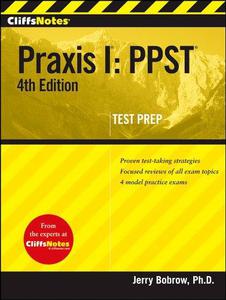 CliffsNotes® Praxis I®: PPST®, 4th Edition By Jerry Bobrow, Ed Kohn, Joy Mondragon?Gilmore, Jean Eggenschwiler(auth.) 2010 | 392 Pages | ISBN: 0470454547 | PDF | 4 MB Your guide to a higher score on Praxis I: PPSTWhy CliffsNotes?Go with a name you know and trustGet the information you need-fast!About the Contents:Part I: IntroductionOverview of the testFAQsProven study strategies and test-taking tipsThe computer-based testPart II: Analysis of Exam AreasReadingMathematicsWriting-Multiple-choice and essayPart III: Mathematics ReviewSymbolsTerminologyFormulasArithmeticAlgebraGeometryPart IV: Selective Review of Grammar and Usage Part V: Four Full-Length Practice TestsThree in paper-based formatOne in computer-based formatComplete answers and explanations for all questions Content: 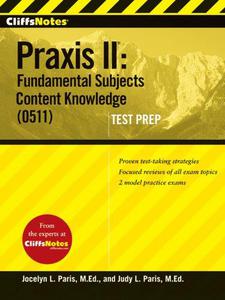 CliffsNotes® Praxis II®: Fundamental Subjects Content Knowledge (0511) By Jocelyn L. Paris, Judy L. Paris(auth.) 2009 | 204 Pages | ISBN: 0470448555 | PDF | 3 MB Content: 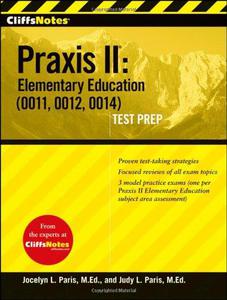 CliffsNotes® Praxis II®: Elementary Education (0011, 0012, 0014) Test Prep By Jocelyn L. Paris, Judy L. Paris(auth.) 2009 | 260 Pages | ISBN: 0470259566 | PDF | 3 MB The book covers three individual Elementary Education tests, all under the Praxis II series: 0011: Curriculum, Instruction, and Assessment test 0012: Content Area Exercises 0014: Content Knowledge The book includes subject review chapters and a full-length practice test for each subject assessment test. Content: 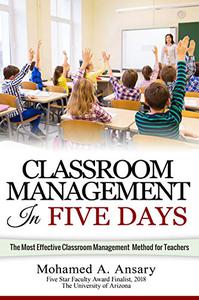 Mohamed A. Ansary, "Classroom: Classroom Management In Five Days: The Most Effective Classroom Management Method for Middle and High School Teachers: Find Out the Classroom Management Secrets, Tips & Tricks" English | 2018 | ASIN: B07JKRGW3Q | EPUB | pages: 93 | 0.4 mb Classroom: Classroom Management In Five Days 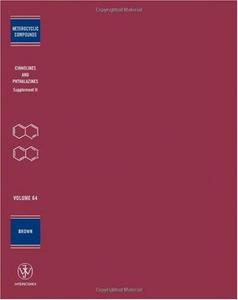 Cinnolines and Phthalazines: Supplement II, Volume 64 By Dr. D. J. Brown(auth.), Edward C. Taylor, Peter Wipf, Arnold Weissberger(eds.) 2005 | 492 Pages | ISBN: 047148587X | PDF | 4 MB This book provides the most comprehensive, current reference on the synthetic chemistry of cinnolines and phthalazines. Applications to the syntheses of natural products and other chiral compounds are described. Volume 64 contains chapters exploring the following topics: * Primary Syntheses of Cinnolines * Cinnoline, Alklycinnolines, and Arylcinnolines * Halogenocinnolines * Oxycinnolines * Thiocinnolines * Nitro-, Amino-, and Related Cinnolines * Cinnolinecarboxylic Acids and Related Derivatives * Primary Syntheses of Phthalazines * Phthalazine, Alklyphthalazines, and Arylphthalazines * Halogenophthalazines * Oxyphthalazines * Thiophthalazines * Phthalazinecarboxylic Acids and Related Derivatives * An Appendix of Tables of Simple Cinnolines and Simple PhthalazinesContent: Chapter 1 Primary Syntheses of Cinnolines (pages 1-32): Chapter 2 Cinnoline, Alkylcinnolines, and Arylcinnolines (H 4, 6, 46; E 1, 18, 300) (pages 33-44): Chapter 3 Halogenocinnolines (H 29; E 121) (pages 45-58): Chapter 4 Oxycinnolines (H 16, 29, 48; E 62, 150, 273) (pages 59-77): Chapter 5 Thiocinnolines (E 170) (pages 79-83): Chapter 6 Nitro?, Amino?, and Related Cinnolines (H 35; E 87, 207) (pages 85-94): Chapter 7 Cinnolinecarboxylic Acids and Related Derivatives (H 11; E 250) (pages 95-108): Chapter 8 Primary Syntheses of Phthalazines (pages 109-171): Chapter 9 Phthalazine, Alkylphthalazines, and Arylphthalazines (H 69, 72; E 324, 338) (pages 173-202): Chapter 10 Halogenophthalazines (H 178; E 514) (pages 203-234): Chapter 11 Oxyphthalazines (H 78, 177; E 364, 375, 445) (pages 235-280): Chapter 12 Thiophthalazines (E 535) (pages 281-290): Chapter 13 Nitro?, Amino?, and Related Phthalazines (H 183; E 560,596) (pages 291-318): Chapter 14 Phthalazinecarboxylic Acids and Related Derivatives (E 638) (pages 319-347):
 Ciba Foundation Symposium 202 - Evolution of Hydrothermal Ecosystems on Earth (And Mars?) By 1996 | 345 Pages | ISBN: 047196509X | PDF | 13 MB This book explores the possibility that life exists on Mars. It provides an interdisciplinary overview of the early evolution of life in hydrothermal ecosystems on Earth, focusing on the problem of remote sensing and incorporating geological work relevant to the search for evidence of early life on Earth and Mars. It discusses the belief that studying thermal spring deposits as part of this search may be the best opportunity to test whether life on earth is a "unique experiment," or whether there is life elsewhere in the solar system. Content: 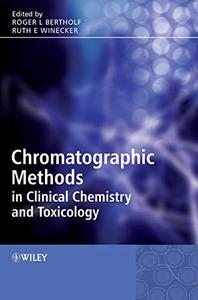 Chromatographic Methods in Clinical Chemistry and Toxicology By 2007 | 306 Pages | ISBN: 0470023090 | PDF | 8 MB This book aims to fill the gap that exists between theoretical treatments of chromatography, and clinical chemistry and toxicology texts, which focus almost exclusively on clinical relevance and applications. Chromatography has a vast array of clinical applications, and though the chromatographic methods were first introduced decades ago, new applications of this technology are being used to explore previously inaccessible frontiers in clinical diagnostics and toxicological testing. An up-to-date book devoted to clinical and toxicological applications of chromatographic methods will serve as an instructional and reference text, useful to students, laboratory technicians, and researchers.Content: Chapter 1 Quality Assurance, Quality Control and Method Validation in Chromatographic Applications (pages 1-14): Michele L. Merves and Bruce A. GoldbergerChapter 2 Liquid Chromatographic?Mass Spectrometric Measurement of Anabolic Steroids (pages 15-32): Don H. Catlin, Yu?Chen Chang, Borislav Starcevic and Caroline K. HattonChapter 3 High?Performance Liquid Chromatography in the Analysis of Active Ingredients in Herbal Nutritional Supplements (pages 33-55): Amitava DasguptaChapter 4 Measurement of Plasma L?DOPA and L?Tyrosine by High?Performance Liquid Chromatography as a Tumor Marker in Melanoma (pages 56-66): Thierry Le Bricon, Sabine Letellier, Konstantin Stoitchkov and Jean?Pierre GarnierChapter 5 Hypersensitive Measurement of Proteins by Capillary Isoelectric Focusing and Liquid Chromatography?Mass Spectrometry (pages 67-86): Feng Zhou and Murray JohnstonChapter 6 Chromatographic Measurement of Transferrin Glycoforms for Detecting Alcohol Abuse and Congenital Disorders of Glycosylation (pages 87-100): Anders HelanderChapter 7 Chromatographic Measurements of Catecholamines and Metanephrines (pages 101-126): Eric C. Y. Chan and Paul C. L. HoChapter 8 Chromatographic Measurement of Volatile Organic Compounds (VOCs) (pages 127-138): Larry A. BroussardChapter 9 Chromatographic Techniques for Measuring Organophosphorus Pesticides (pages 139-169): H. Wollersen and F. MusshoffChapter 10 Chromatographic Analysis of Nerve Agents (pages 170-196): Jeri D. Ropero?MillerChapter 11 History and Pharmacology of ??Hydroxybutyric Acid (pages 197-216): Laureen MarinettiChapter 12 Liquid Chromatography with Inductively Coupled Plasma Mass Spectrometric Detection for Element Speciation: Clinical and Toxicological Applications (pages 217-273): Katarzyna Wrobel, Kazimierz Wrobel and Joseph A. CarusoChapter 13 Applications of Gas Chromatography?Mass Spectrometry to the Determination of Toxic Metals (pages 274-285): Suresh K. Aggarwal, Robert L. Fitzgerald and David A. Herold 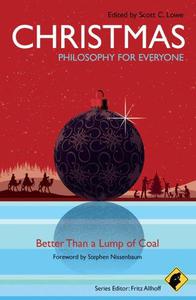 Christmas - Philosophy for Everyone By Scott C. Lowe (ed.) 2010 | 244 Pages | ISBN: 144433090X | PDF | 3 MB From Santa, elves and Ebenezer Scrooge, to the culture wars and virgin birth, Christmas- Philosophy for Everyoneexplores a host of philosophical issues raised by the practices and beliefs surrounding Christmas. Offers thoughtful and humorous philosophical insights into the most widely celebrated holiday in the Western world Contributions come from a wide range of disciplines, including philosophy, theology, religious studies, English literature, cognitive science and moral psychology The essays cover a wide range of Christmas themes, from a defence of the miracle of the virgin birth to the relevance of Christmas to atheists and pagans Content: Chapter 1 Jesus, Mary, and Hume (pages 9-23): Zachary Jurgensen and Jason SouthworthChapter 2 The Virgin Birth (pages 24-35): Victor LyonsChapter 3 Putting the "Yule" Back in "Yuletide" (pages 36-46): Todd PrestonChapter 4 Armed for the War on Christmas (pages 47-58): Scott F. AikenChapter 5 Christmas Mythologies (pages 59-69): Guy Bennett?HunterChapter 6 The Significance of Christmas for Liberal Multiculturalism (pages 70-79): Mark MercerChapter 7 Crummy Commercials and BB Guns (pages 80-90): Erin Haire and Dustin NelsonChapter 8 The Mind of Santa Claus and the Metaphors he Lives by (pages 91-103): William E. Deal and S. WallerChapter 9 Making a List, Checking it Twice (pages 104-113): Richard Hancuff and Noreen O'ConnorChapter 10 You'd Better Watch out... (pages 114-124): Will WilliamsChapter 11 Santa's Sweatshop (pages 125-135): Matthew BrophyChapter 12 Against the Santa Claus Lie (pages 137-150): David Kyle JohnsonChapter 13 Lying to Children about Santa (pages 151-160): Era GavrielidesChapter 14 Putting Claus Back into Christmas (pages 161-171): Steven D. HalesChapter 15 Scrooge Learns it All in One Night (pages 172-182): Dr. Dane ScottChapter 16 Holly Jolly Atheists (pages 183-196): Ruth TallmanChapter 17 Heaven, Hecate, and Hallmark (pages 197-207): Marion G. MasonChapter 18 Festivus and the need for Seasonal Absurdity (pages 208-218): Caleb HoltChapter 19 Common Claus (pages 219-230): Cindy Scheopner 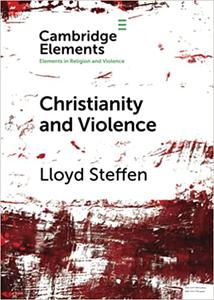 Lloyd Steffen, "Christianity and Violence " English | ISBN: 1108796699 | 2021 | 100 pages | PDF | 2 MB How Christian people have framed the meaning of violence within their faith tradition has been a complex process subject to all manner of historical, cultural, political, ethnic and theological contingencies. As a tradition encompassing widely divergent beliefs and perspectives, Christianity has, over two millennia, adapted to changing cultural and historical circumstances. To grasp the complexity of this tradition and its involvement with violence requires attention to specific elements explored in this Element: the scriptural and institutional sources for violence; the faith commitments and practices that join communities and sanction both resistance to and authorization for violence; and select historical developments that altered the power wielded by Christianity in society, culture and politics. Relevant issues in social psychology and the moral action guides addressing violence affirmed in Christian communities provide a deeper explanation for the motivations that have led to the diverse interpretations of violence avowed in the Christian tradition. |